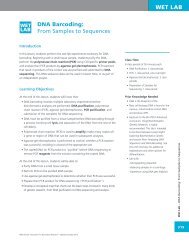LESSON 4 Using Bioinformatics to Analyze Protein Sequences
LESSON 4 Using Bioinformatics to Analyze Protein Sequences
LESSON 4 Using Bioinformatics to Analyze Protein Sequences
You also want an ePaper? Increase the reach of your titles
YUMPU automatically turns print PDFs into web optimized ePapers that Google loves.
<strong>LESSON</strong> 415. Show Slide #6. When mRNA molecules are translated, translation starts atthe start codon, AUG (circled). In the DNA, this sequence is ATG (also circled).When genetic researchers study genes, they often do not write down thecomplementary DNA sequence, the mRNA sequence, and the tRNAs. They use a“short cut.” Because the coding sequence of the DNA and the sequence of themRNA are the same (except for the thymines instead of uracils), you can predictthe protein sequence just by looking at the gene, if you know where <strong>to</strong> start.16. Now it is time <strong>to</strong> practice translation. Show Slide #7, which contains aclassic codon table, and remind students that amino acids are encoded bynucleotide triplets called codons. Walk students through the codon table,using the start codon ATG [AUG] as an example. Remind students thatprotein translation starts with the start codon ATG [or AUG]. The codon tablecontains U’s (uracil) instead of T’s (thymine), but otherwise the sequence of thegene and the mRNA are the same. The start codon tells the protein-makingmachinery in the cell where <strong>to</strong> start making protein from an mRNA molecule.• Begin with the “First Position” column, moving down <strong>to</strong> row “A.”• Next move <strong>to</strong> the “U” column under the heading “Second Position.”• Within the box where the First Position row and the Second Position columnmeet, there are four codons representing the four possible nucleotides forthe Third Position. The codon “AUG” is the start codon and also encodesthe amino acid methionine (M).Start codon: A three-nucleotide triple<strong>to</strong>r codon that tells the cell when <strong>to</strong> startprotein translation. The start codon isATG (or AUG in mRNA).Amino acid: Amino acids are thebuilding blocks of proteins. Every aminoacid contains an amino group and acarboxylic acid group (which is why theyare called “amino acids”). Each aminoacid also contains a unique side chain orR-group, which gives the amino acid itschemical properties (such as hydrophobic,hydrophilic, acidic, or basic). There are20 different amino acids specified by thegenetic code. In a protein, amino acidsare joined <strong>to</strong>gether by bonds between theamino and carboxyl groups.<strong>Bioinformatics</strong> & <strong>Protein</strong>s: Slide #717. Pass out copies of Student Handout—Codons and Amino Acid Chemistry,one per student.18. Next show students Slide #8, which is a representation of the codontable in circular form. Explain <strong>to</strong> students that this codon table contains thesame information as the previous table, but in a different format. Point out<strong>to</strong> students that this table contains the amino acid names, as well as thethree-letter and single-letter amino acid abbreviations. Tell students that mostbioinformatics <strong>to</strong>ols use the single-letter amino acid abbreviations, so theyshould refer <strong>to</strong> this handout during their work.Lesson 4 – <strong>Using</strong> <strong>Bioinformatics</strong> <strong>to</strong> <strong>Analyze</strong> <strong>Protein</strong> <strong>Sequences</strong>127©Northwest Association for Biomedical Research—Updated Oc<strong>to</strong>ber 2012
















